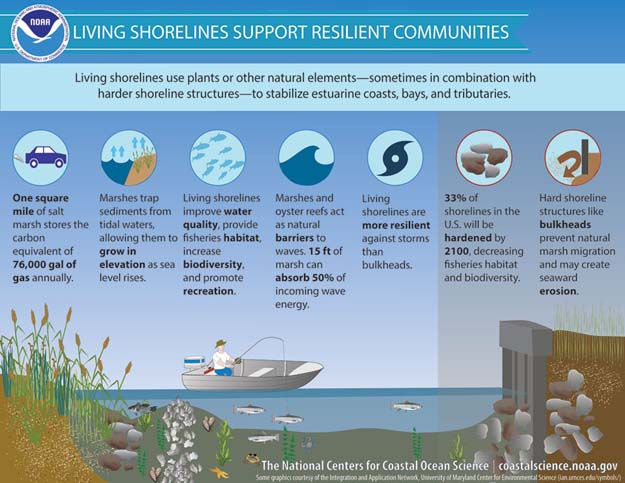A protected and stabilized shoreline is made of natural materials – plants, sand, or rock.
[dropcap]L[/dropcap]iving shorelines use plants or other natural elements to stabilize estuarine coasts, bays, or tributaries.1. Living shorelines are a green infrastructure technique using native vegetation alone or in combination with offshore sills to stabilize the shoreline. Living shorelines provide a natural alternative to ‘hard’ shoreline stabilization methods like stone sills or bulkheads, and provide numerous benefits including nutrient pollution remediation, essential fish habitat provision, and buffering of shoreline from waves and storms.
2. Living shorelines are known to store carbon (known as carbon sequestration), which keeps carbon out of the atmosphere. Continued use of this approach to coastal resilience will result in increased carbon sequestration and storage, potentially mitigating the effects of climate change.
Infographic Text
Living Shorelines Support Resilient Communities
- Living shorelines use plants or other natural elements—sometimes in combination with harder shoreline structures—to stabilize estuarine coasts, bays, and tributaries.One square mile of salt marsh stores the carbon equivalent of 76,000 gal of gas annually.
Marshes trap sediments from tidal waters, allowing them to grow in elevation as sea level rises.
Living shorelines improve water quality, provide fisheries habitat, increase biodiversity, and promote recreation.
Marshes and oyster reefs act as natural barriers to waves. 15 ft of marsh can absorb 50% of incoming wave energy.
Living shorelines are more resilient against storms than bulkheads.
33% of shorelines in the U.S. will be hardened by 2100, decreasing fisheries habitat and biodiversity.
Hard shoreline structures like bulkheads prevent natural marsh migration and may create seaward erosion.NOTE: Featured Image – NOAA image.



